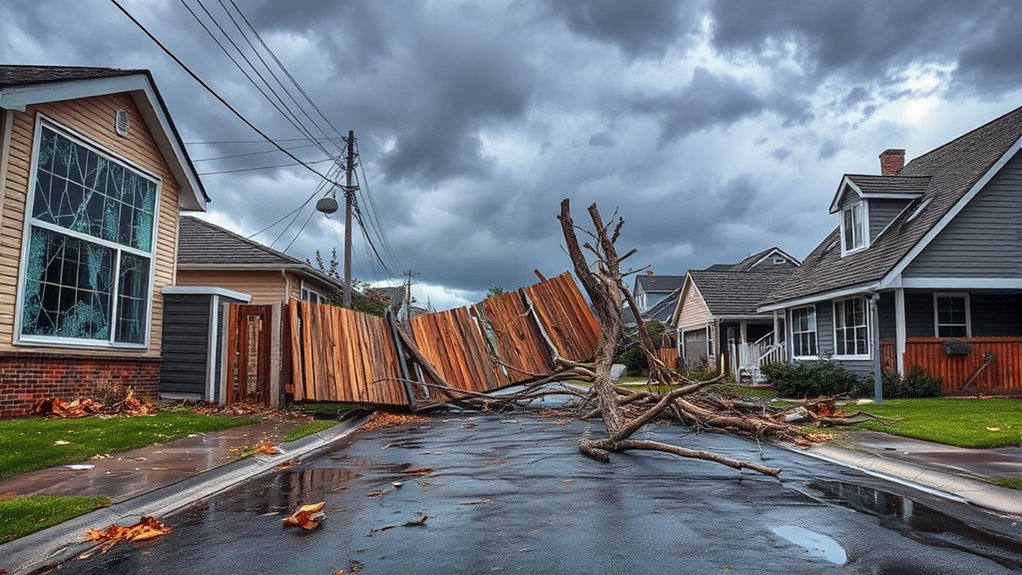To document storm damage for insurance, start with a thorough walkthrough of your property, noting all affected areas including minor damages. Take high-quality photos from multiple angles and close-ups before repairs begin, and organize them by date. Write detailed descriptions of each damaged item or area, including the cause if possible. Keep receipts, repair estimates, and records of communication. Staying organized helps make certain your claim is accurate and processed smoothly—continue to discover more tips to strengthen your claim.
Key Takeaways
- Conduct a thorough walkthrough to identify and note all storm-related damages, including minor issues.
- Capture high-resolution photos from multiple angles and include close-ups before repairs begin.
- Organize photos with date-specific folders, preserving original files for evidence integrity.
- Write detailed descriptions of each damaged item, including location, cause, and extent of damage.
- Collect receipts, estimates, and records of communication to support and expedite the insurance claim.

When a storm causes damage to your property, detailed documentation is essential to guarantee your insurance claim is processed smoothly. Properly documenting the damage ensures that your claim filing is accurate and that you receive the compensation you need to repair or replace what was lost. The first step is to conduct a detailed damage assessment. Walk through your property carefully, noting every affected area, whether it’s a fallen tree on your roof, broken windows, or flooding in your basement. Take your time to identify all damages, no matter how minor they seem. This extensive assessment helps prevent delays in processing your claim and ensures nothing gets overlooked.
Once you’ve completed your damage assessment, gather visual evidence to support your claim. Use your smartphone or camera to take clear, high-resolution photos of the damage from multiple angles. Capture close-up shots to highlight specific issues, like cracks in the foundation or shredded roofing material, as well as wide shots that show the overall extent of the damage. It’s best to photograph the damage as soon as possible, ideally before any repairs are made, to preserve the evidence. Remember to date the photos or keep them in a folder organized by date, which can be useful when submitting your claim.
Take clear, high-resolution photos from multiple angles before repairs to document storm damage effectively.
In addition to photographs, create a detailed written record. List each damaged item or area, describe the nature of the damage, and note the date and location. Include any relevant details, such as whether the damage was caused by falling debris or flooding. This written documentation aids in the claim filing process, providing your insurance company with a clear understanding of the scope of the damage. If you have receipts or estimates for repairs, gather those as well, since they can support your claim for damages and help establish the value of the loss.
Don’t forget to keep track of any expenses you incur due to the storm damage, such as temporary repairs or accommodations if your home becomes uninhabitable. Keep copies of all communication with contractors, adjusters, and insurance representatives. When you submit your claim, providing thorough documentation — including photos, written descriptions, receipts, and estimates — will streamline the process and reduce the chances of disputes or delays. Remember, the goal is to present a complete, precise picture of the damage, making it easier for your insurer to process your claim efficiently and fairly. Additionally, understanding the importance of indoor air quality can help homeowners take extra steps to ensure healthy living conditions during repairs.
Frequently Asked Questions
How Soon Should I File My Insurance Claim After a Storm?
You should file your insurance claim as soon as possible after the storm, ideally within the emergency reporting timeframe specified by your insurer. Promptly reporting the damage helps guarantee your claim is processed quickly and increases your chances of receiving full coverage. Don’t delay, as waiting too long could complicate the timing of your claim and potentially lead to denied coverage. Act quickly to protect your rights and get the help you need.
What Types of Storm Damage Are Typically Covered by Insurance?
You’re typically covered for storm damage like hail damage and flood damage if your policy includes those protections. Hail damage can affect your roof, siding, and windows, while flood damage often covers water intrusion into your basement or foundation. Check your policy details to verify coverage, and document all damage thoroughly. Acting quickly helps ensure you meet claim deadlines and get the repairs you need promptly.
Can I Claim for Future Storm Damage Prevention Measures?
Think of storm prevention as an investment in your future peace of mind. While you can’t typically claim for future storm damage prevention measures, some insurance policies may offer coverage for upgrades that reduce risks. it is crucial to review your policy details and discuss with your insurer about storm prevention options. Taking proactive steps now could save you from bigger worries—and expenses—when the next storm hits.
How Do I Handle Disputes With My Insurance Company?
If you’re disputing a claim denial, start by reviewing your insurance policy and gather supporting evidence. You can initiate the appeal process through your insurer and consider using mediation options if disagreements persist. Stay persistent, communicate clearly, and keep detailed records of all correspondence. If needed, seek advice from a consumer advocate or legal expert to help navigate the dispute and guarantee your rights are protected.
Are There Specific Photos or Documentation Standards Required by Insurers?
Your insurer typically requires clear photos following specific photo guidelines and documentation standards. Make certain to capture wide shots of the entire property and close-ups of damaged areas, emphasizing details like cracks or missing shingles. Take photos from different angles, include date stamps if possible, and avoid cluttered backgrounds. Follow your insurer’s instructions carefully to guarantee your documentation is accepted, and keep detailed records of all damages and repairs for your claim.
Conclusion
By thoroughly documenting storm damage, you protect yourself and guarantee a smoother insurance claim process. Take clear photos, keep detailed records, and stay organized—these steps make all the difference. Remember, a stitch in time saves nine, so don’t wait until it’s too late. Being prepared now means you won’t be caught off guard later. Stay vigilant, and you’ll weather the storm with confidence, knowing you’ve done everything to safeguard your home and peace of mind.









